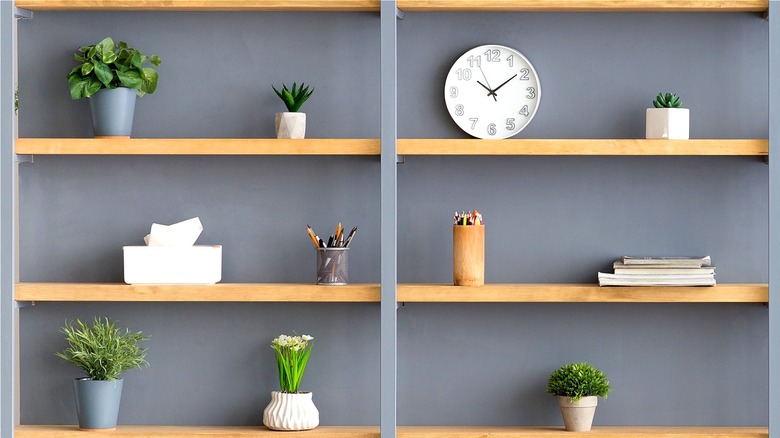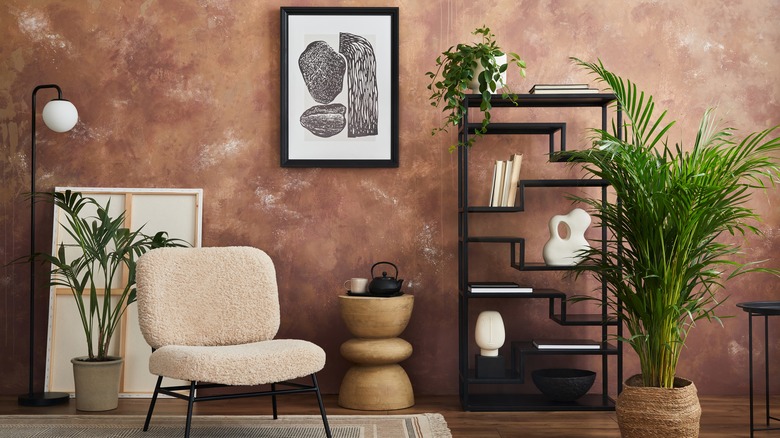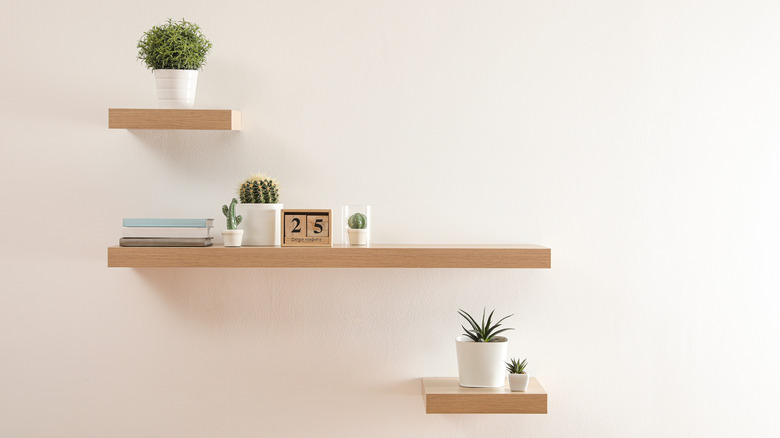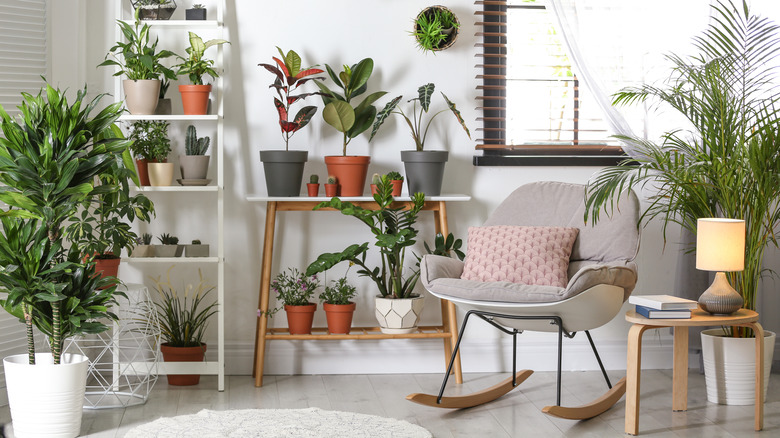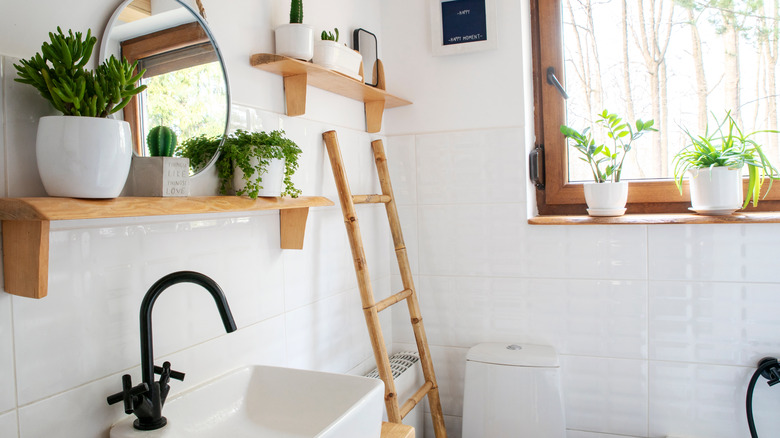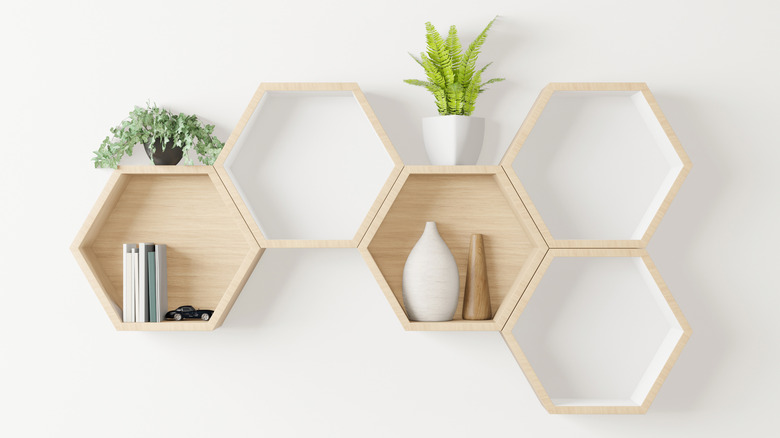Elevate Your Plant Shelf With These 5 Smart Styling Touches
Decorating your home with plants will not only elevate your style but can improve your health as well. Houseplants add a natural element to any room with a pop of color and texture, and setting them on a shelf near a window will ensure they get the sunlight they need to flourish. When they're properly taken care of, you'll be able to reap their health benefits as well.
Piedmont Healthcare explains that plants can improve the air quality in your home by removing toxins from the air, like formaldehyde and benzene. They can do this because when they photosynthesize, they take in carbon dioxide and other toxins to replace with fresh oxygen. For this reason, plants with bigger leaves will be more effective at improving air quality.
Lauren Garvey, LPC, a counselor at Piedmont, also notes that houseplants can have a positive effect on the people who care for them, including helping to alleviate anxiety symptoms and improve one's focus, adding, "I also think plants are hopeful. As they grow and blossom, they can be an important reminder for us of things to come."
These health benefits make owning houseplants beneficial in more ways than just as decorative pieces. As for the design side, here are five ways you can elevate your plant shelf (or shelves) and make the most of this natural and rewarding partnership with plants.
1. Add other decor items
Plants alone look gorgeous on your shelves, but displaying other decor items with them can take the design up. When you have plants with a lot of green foliage, adding a painting beside them can bring in even more color. Livspace recommends choosing artwork with bold colors that complements your plants. Don't worry if you don't want to add artwork like paintings, prints, or sketches; there are many other forms of art you can choose from.
Sculptural pieces, for example, will also look great beside your plants. They can be painted with colorful patterns or left solid. Books, meanwhile, are the perfect piece of decor to add varying heights and more neutral colors. Just be careful when watering your plants if they sit on top of a book, and use saucers to catch any moisture from the drainage holes. Knickknacks are another way to fill in the blank space on your shelves.
2. Keep it cohesive
Creating a cohesive design for your plant shelf will make it look more purposeful rather than like a mismatch of pots, plants, and decor pieces. Rare and Worthy explains one way to make plant shelves look more cohesive is by sticking to a color scheme. Choose one to three colors to stick to when picking your planters. You can still choose patterned pots, but ensure the colors fit into the scheme.
Using neutral colors is an easy way to build a cohesive look. A tip to staying in the color scheme is that once you find a pot you like, purchase it in varying sizes. Then you can have different plants in the same style of pot. You can also add variation by choosing planters of different shapes and textures.
When searching for decorative pots, you'll notice many don't have a drainage hole. This is an important feature to keep your plants from getting root rot. If your planters don't have a hole in the bottom, you can drill one with a ceramic bit. An easier solution is to keep your plant in its nursery pot and place it in the decorative one.
3. Don't be afraid to add artificial plants
There's nothing wrong with adding artificial plants to your shelf. Each plant species is unique in how it looks and what it needs to survive. They may look beautiful on your shelf, but they won't be there long if they can't get the right amount of sunlight. Sometimes the sun is too bright and burns their leaves, or it's not bright enough, and they slowly die. As an alternative, choose a synthetic version to get the same look as the plants you like without worrying about putting them in the wrong environment.
You can use fake plants to fill in the gaps between your real ones or use them for your entire shelf. Luckily, there are a couple of tricks you can do to make these plants look real. Plants don't look perfect or symmetrical so spreading out the foliage and trimming flaws into leaves is the first thing you can do. Then Dream a Little Bigger recommends adding a layer of actual soil to the top or gluing in fake dirt. To do this, mix coffee grounds, sand, a touch of black paint, and white glue. Take that mixture, and place it in the pot of your fake plant.
4. Don't forget about lighting
The amount of light that reaches your plant shelf affects how you can decorate it. You'll need at least indirect sunlight since even the plants that tolerate low light will thrive with more. Some plants need bright indirect sunlight, which will burn the plants that don't. Before you choose where to put your plant shelf, plan out which houseplants you'll display on it. Lonny explains that a tip to follow is the darker a plant's leaves are, the more shade it will need.
Add sheer curtains to your windows if your plants need less sunlight, and you don't want to move your shelf. Grow lights are the perfect solution if you need more sun. If you have an outlet nearby and hide the cords, you can provide your plants with as much light as they need. You can also buy just the bulb and put it in a light fixture that matches your decor.
5. Think outside of planters
To elevate your plant shelf, you need to think about the design in other ways than with planters. Pots are a great way to style your plants, but using their natural foliage as decor will make your shelf look even better. Plants with trailing vines will utilize the vertical space on your wall, making the eye look up so that a small room appears to have more space. Spider plants and ferns have lots of texture that you can utilize in your design. Stauffers of Kissel Hill recommends using fiddle leaf figs or rubber trees if you have a mid-century modern decor style. If you prefer a farmhouse style, use aloe, eucalyptus, or herbs.
Placing your plants according to the rule of three will also step up your design (via Talie Jane Interiors). This rule works because when you place odd amounts of decor in sets of three, it looks more pleasing to the eye. You can implement this by grouping your plants in threes on the self with other decor placed between them.
